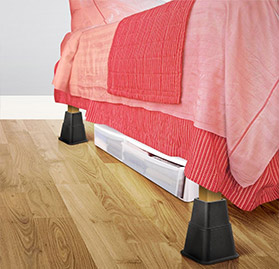The aging process is usually accompanied by declines in muscle strength, endurance and balance. These early signs sometimes show themselves in many ways, but one well noticed symptom is difficulty with getting out of bed.
This article will highlight the most commonly used devices by the elderly to get out of bed.
Bedrail
This is a senior aid that can be secured to the bed or near the bed. This assistive aid can work by allowing a user in a lying down position to pull on the handle to right themselves up into a sitting position at the side of the bed. From here, the user can then push off of the railing which is adjacent to them to support themselves as they get into standing.

Most models have a pair of metal poles or a board that goes underneath the mattress. It is usually secured in place by the user’s weight on the mattress, mattress itself or tied down with done straps. Some seniors may complain of back pain and discomfort when lying on these devices, so some people chose to seek alternative bedrail designs. Other types of bedrails include one that can be bolted into the flooring or a swing away railing can be drilled into the wall near the head of the bed. These options are usually not considered as they have some significant disadvantages:
- Usually considered permanent installations as securement points need to be placed into the floor or wall. This can affect the resale value of the home and home owners reconsider this option when they learn this. Similarly, few landlords will authorize home modifications like this, especially when there are other more simple devices to help with transfers and safety.
- These devices are generally not considered portable. They cannot be removed easily to be taken with the user on day trips or extended vacations. If one chooses to move to a new home, once again new holes must be made in the wall and flooring to secure the transfer aid.
- These tools need to be installed professionally to ensure they are safe to use. The need for a professional tradesmen to setup the device makes it significantly more expensive. In contrast, bedrails that are supported by a board or railings underneath the mattress, are significantly less expensive and can be secured by almost any family member.
- Once the bedrail is installed in the floor or against the wall, relocating the bed would make the railing itself useless. Thus if one has to move their bed for whatever reason, they will render their investment useless. Possible reasons why one may need to move their bed includes the need to rearrange furniture to clear walking pathways for mobility aid usage, relocating bed to the main floor living room (from a second floor bedroom) after one has difficulty with climbing stairs to the second floor, etc.
Electric Hospital Bed
An electric powered hospital bed is usually used for people that have complex medical conditions. These bed frames are motor driven and can connected to a normal electrical outlet. Controlled by a remote control or by a panel on the side rails, this bed can be used to assist an individual with impaired weight shifting, repositioning and difficulties getting in and out of bed.
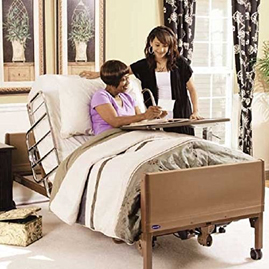
In order to facilitate a change in position from lying to sitting at the edge of the bed, raise the headrest to a comfortable angle (approximately 45 degrees works best). This propels the user into a position where they are already partially sitting. From there the user can move their legs over the edge or a caregiver can assist with this motion if needed until the user reaches a position at the bed’s edge
Once sitting at the edge of the bed, the height of the bed from the floor can be adjusted. If the bed height is too low, the user will themselves be sitting low and experience a greater difficulty with getting into standing. The more the individual’s body has to rise, the more energy needs to be consumed to accomplish this change in posture and some older adults may not have sufficient strength for this. If the user attempts to get out of bed with the bed raised too tall, they may not feel confident in their footing (or might be unable to reach the floor). This can result in an abrupt drop until the lower body reaches the floor and can contribute to a fall. Whenever someone uses a hospital bed, it is usually because they have significant functional deficits, so it is usually recommended that a physiotherapist or occupational therapist assess the individual for safety with hospital bed usage. Once the height of the bed has been adjusted appropriately, the user can push off the bed mattress or railing to get into standing. Alternatively, they can also use any nearby aids for support like a transfer pole if accessible.
Transfer pole
Before we explain what a transfer pole does, we’d like to highlight that this device is known by various other names:
- Super pole (with or without a horizontal bar)
- Transfer pole
- Safety pole
- Floor to ceiling pole
- Security pole
- Stripper pole (a name only used by the most kinky senior citizens)
- Fireman’s pole
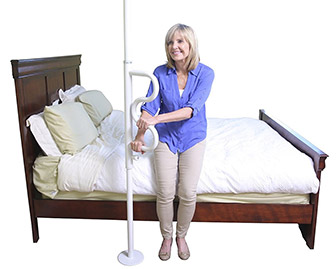
Transfer pole allows seniors to pull on it to help with getting out of bed.
A floor to ceiling pole is a great assistive aid to help seniors with aging safely at home. This device is usually held in place by tension between the floor and ceiling and can be relocated as needed. That said some models require securing the transfer aid in place with screws. It is normally found in multiple locations such as the bathroom, living room and bedroom. When placed near a bed, it can be pulled on to help one get into standing. Alternatively, if a horizontal bar attachment is present, and within close proximity to the bed, one could also push off of the bar to get into standing. As well, this horizontal bar can be used to weight shift along the mattress if required.
In order to determine one’s needs, and whether this device is an appropriate tool for the older adult, a home safety assessment by a community therapist like an OT or PT is recommended. These healthcare providers will give you a sense of whether one’s muscle have sufficient strength and endurance for pulling or pushing, and will recommend the best location for where the security pole should be installed. One last warning about this device, seasonal changes in weather may affect the tension of this device as it causes the walls and flooring to expand or contract. As a result, it is important to check the security of this device on a regular basis to ensure safety with each use.
Gait aid
Sometimes older adults need to rely on a gait device like a cane to help them with walking balance and stability as they leave bed. From sitting at the side of the bed, the senior needs to scoot to the edge as far as they can. From here, they can opt to push off the bed with one hand and push down on the cane with the other. As they transition from sitting to standing, they put more force into the hand holding the cane and can begin to ambulate. This ensures that the senior is always supported by at least one item as they stand (whether it is the bed as the begin the transfer or the cane once they are ready to walk). Different types of canes exist, but generally as more points exist at the base, the greater support it provides. The most common types of cane bases includes a single point base, tripod base, small quad base or a large quad base. As one progresses through the various bases, stability increases for the cane to stand upright on its own, and the user’s balance improves with its usage.
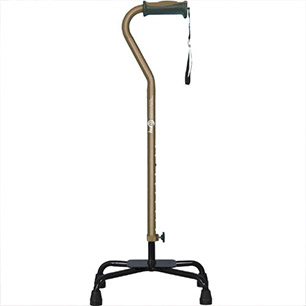
Walker or rollator mobility aid
A wheeled walker (also known as a rollator walker) is a common device used by seniors that need assistance with their mobility. When one’s physical abilities decline to the point where they need to use a walker, they also sometimes experience difficulty with transferring out of bed. Thankfully a walker can used in this situation to support getting out of bed. That said, it is also one of the most misused devices that can lead to falls and/or fatal injury. Seniors generally see a walker as a strong and supportive base (usually because it is quite wide), and pull themselves into standing by grabbing onto the arm handles. However, this tilts the walker back towards the person and as the front wheels or points lift off the ground. This makes the large stable base incredibly small and the walker becomes less stable. Essentially, pulling on the walker to get one into standing increases one’s fall risk significantly.
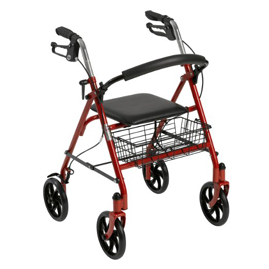
The correct way to use a walker to support standing from bed is to push off of the bed with two hands, and once in standing use the walker to ambulate away. The only other way a walker can be used is to push off the bed with one hand, while the other hand grasps onto the walker for minimal balance support. Note that we said balance support, and not pulling on the walker itself. So this means that the user can only apply a downward force onto the arm handle to minimize the risk of it sliding away, rolling away or tilting towards the user.
In essence this tool is not really considered a transfer device, but more of a mobility aid that can augment and make the transfer from a bed more safe. To ensure this is movement is being performed correctly, one needs to ensure the brakes (if it is a rollator walker) are always locked prior to leaving or using the walker for any purpose. More importantly, a trained occupational therapist or physiotherapist needs to review walker safety with the intended user to ensure that the device is safe and appropriate for their medical and physical condition.
Grab bars
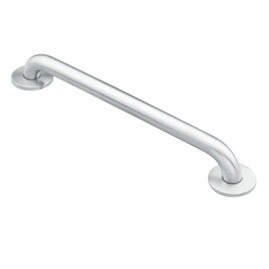
If the bed is sufficiently close to the wall, and the senior has ample pulling strength, they can use grab bars to safely get out of bed. Note that grab bars need to be placed in studs to ensure that they are secure. This may affect the precise location of grab bar, and may lead to a less than optimal placement on the wall. As a result of this, grab bars are usually not found in bedrooms. Moreover, the sides of most beds are not usually within reach of a wall. As an example, nightstands usually sit between the bed and the wall which forces the bed to be further away from the wall. When this occurs, the grab bar is usually too far away to be used as a supportive device and is considered to have poor accessibility. That said, some bedrooms can have a grab bar that flips up and down installed on the wall near the head of the bed. When the grab bar is in the down position, it can be used for support to pull oneself to the edge of the bed and pushed off of to get into standing.
Foam Bed Wedge
The most difficult part of getting out of bed is the act of going from lying on your back (supine position) to sitting at the edge of the bed. Seniors often struggle with this because lifting the torso requires a moderate amount of strength and endurance. However, if a foam bed wedge is inserted behind the pillow, this allows the user to sleep and lie down with their upper body partially elevated. When required to get out of bed, it is not as difficult because they would be partially sitting up already. This device is inexpensive and its portability means it can be carried in one’s luggage when going on short trips or vacations. However, one disadvantage is that the foam tends to deteriorate over time and the wedge to be replaced on occasion.
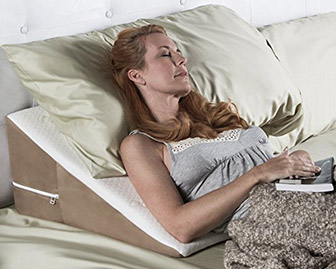
 Furniture risers
Furniture risers
Seniors commonly cannot get out of bed because their frame and mattress are too low to the ground. Because they are sitting low in comparison to a standing posture, it makes standing a challenging task. Risers are a low tech way of correcting this issue. With wooden blocks or plastic risers, the bed can be raised a few inches higher. A taller bed will make the individual sit higher and thus be more capable of independently getting out of bed. It is simple and inexpensive to add to almost any bed, but it should be noted that frames with wheels are usually not compatible with this device. Ideally you want the bed legs to be stationary so the risk of the feet shifting within the furniture riser is minimal.
